
Helenium, Sneezeweed: Planting, Growing and Care
Contents
Helenium in a nutshell
- Helenium, radiant and sun-loving, offers a long, blazing bloom throughout summer and autumn
- Its distinctive daisy-like flowers in shades of yellow, orange, red, and copper bloom continuously from summer right through to autumn
- Extremely easy to grow, it thrives in sunny spots and fertile soil that remains reasonably moist
- This is a hardy, robust plant that’s fully winter-proof and disease-resistant
- Alongside Asters, Helenium is THE essential autumn perennial for cottage gardens, English-style mixed borders and floral arrangements
Our expert's advice
With its abundant, unconventional daisy-like blooms, Helenium or Sneezeweed is an essential summer and autumn perennial with large flowers, perfect for all cottage or wild-style gardens.
Featuring prominent, domed central discs, the copper-red ‘Moerheim Beauty’, ‘Ruby Tuesday’, the pink ‘Tie Dye’, the canary-yellow autumnale, Helenium puberulum, and Helenium bigelovii (Bigelow’s Sneezeweed) all warm the garden with their symphony of fiery hues, sometimes lasting well into autumn. There’s a Helenium for every gardener!
With its bold presence, it sets the garden ablaze, creating wild, vibrant displays! Its sun-loving blooms are classic staples in mixed borders and sunny flowerbeds, bringing exuberance and whimsy.
This hardy, low-maintenance perennial thrives in any garden, in full sun and moist, well-drained soil. Easy to pair and highly versatile, it quickly forms lush clumps with exceptional floriferousness, offering warm-toned blooms that brighten late summer and early autumn.
Explore our Helenium collection to find the perfect variety for your garden and bouquets!

Description and botany
Botanical data
- Latin name Helenium
- Family Asteraceae
- Common name Sneezeweed, autumn daisy
- Flowering from June until autumn
- Height 0.60 to 1.50 m
- Exposure Sun
- Soil type All types, well-drained
- Hardiness -15°C to -20°C depending on varieties
Helenium or Sneezeweed, sometimes called “autumn daisy“, is a perennial from the Asteraceae family, like its cousins the daisy and aster. It is native to the wet meadows, marshes and edges of swamps in North America.
The Helenium genus includes about 40 species of perennial, annual or biennial sneezeweeds. They have given rise to over 70 hybrids and cultivars with interesting variations in shape, height and colour, such as ‘Moerheim Beauty’, the most popular of all heleniums, or ‘Ruby Tuesday’.
Most hybrids originate from Helenium autumnale. Other species commonly found in our gardens include Helenium hoopesii, Helenium puberulum and Helenium bigelovii or “Bigelow’s sneezeweed”.
This perennial has an upright, clump-forming habit, quite compact, somewhat untidy, easily reaching 1.50 m in height and 50 cm in width for the most imposing varieties.
Although it has rapid growth, helenium needs about two years to establish well, then it grows over the years to form dense, floriferous clumps, which can even become invasive. Once established, it can live for many years.
From a basal rosette of leaves emerge in spring tall, slender yet sturdy stems, more or less branched in their upper part. Exceptionally sturdy and wind-resistant, they generally don’t require staking.
Helenium has vigorous growth whose main appeal lies in its abundance. Deciduous, the foliage resembles that of daisies and Echinacea. The upright stems are dotted with narrow leaves 10 to 30 cm long, lance-shaped and slightly toothed. Smaller towards the top of the stems, they are arranged alternately. They can be quite thick and range from bright green to dark green or bluish-green.
Conquering and radiant, the flowers of Helenium, this close relative of the sunflower, are decidedly solar in beauty. The warm tones of this bloom herald autumn’s fiery colours.
We distinguish between early-flowering heleniums that bloom from May to July and late-flowering or “autumn heleniums” whose flowering extends from August to the onset of winter. From June to November, depending on the variety, the stems bear inflorescences in large, long-lasting flower heads 2 to 10 cm in diameter, reminiscent of daisies, Rudbeckias or Echinacea.
All summer long until frost, a myriad of flowers blooms tirelessly, sometimes grouped in corymbs of 3 to 8 at the stem tips.
They consist of a well-rounded hemispherical cone coloured chocolate brown, old gold or amber, which can sometimes be very prominent, forming a small rounded cushion that gradually becomes dotted with yellow stamens. The heart of this pompon is surrounded by a collar of fine petals or ray florets, sometimes very rolled, arranged in one or two rows (Helenium ‘Double Trouble’). Tightly packed, they are slightly notched with 3 to 5 teeth at their tip and can spread almost horizontally or conversely bend noticeably downward when mature, as in Helenium hoopesii.
These wide-open corollas display vibrant, particularly flamboyant autumn colours, taking on all warm shades, from the brick red of Helenium Moerheim Beauty, to the ruby red of Helenium ‘Ruby Tuesday’, to the bright orange to coppery of Helenium ‘Short’n ‘Sassy’ or the sunny yellow of Helenium ‘Kugelsonne’. Some multicoloured or bicoloured florets are variegated with yellow, red, orange and copper.
This remarkably generous flowering, lasting 6 to 10 weeks, colourful and nectar-rich, is staggered throughout summer: the flowers renew themselves continuously until autumn in borders bustling with bees and butterflies.
The fresh flowers, long-lasting in vases, make beautiful summer bouquets, sparkling and fiery.
Very hardy, well beyond -15°C, helenium can be grown in all regions. Never diseased, Helenium is easy to grow in full sun, in any good garden soil that remains somewhat moist, although it will be more exuberant in soil rich in organic matter. It’s a robust, well-behaved plant that can temporarily withstand intense heat and drought.
It brightens up naturalistic borders, enlivens slopes, enchants English-style mixed borders. Some varieties are also suitable for container growing.


From left to right: Helenium autumnale ‘Mardis Gras’, Helenium ‘Zimbelstern’, Helenium ‘Baudirektor Linne’, Helenium ‘Double Trouble’, Helenium ‘Bandera’.
Main species and varieties
The complex, warm colours and varying heights (from 0.60 to 1.50 m) of Heleniums offer an infinite variety of warm hues ranging from yellow to ruby red, including coppery orange, with many cultivars now available such as ‘Moerheim Beauty’, the most popular of all heleniums, or ‘Ruby Tuesday’.
We distinguish between early-flowering heleniums that bloom all summer and late-flowering varieties or “autumn daisies” which begin flowering in summer and reach their peak in autumn.
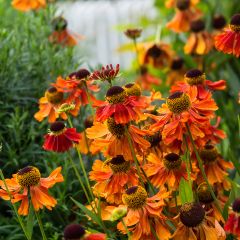
Helenium Moerheim Beauty
- Flowering time July to October
- Height at maturity 90 cm
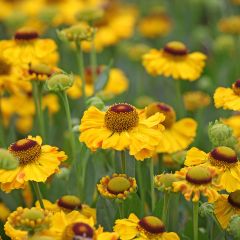
Helenium El Dorado
- Flowering time August to October
- Height at maturity 1 m

Helenium Ruby Tuesday
- Flowering time September to November
- Height at maturity 55 cm

Helenium Sahins Early Flowerer
- Flowering time August to December
- Height at maturity 1 m
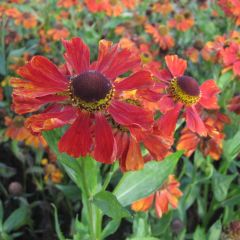
Helenium Baudirektor Linne
- Flowering time August to October
- Height at maturity 1,50 m
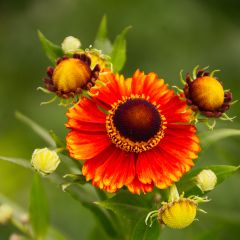
Helenium Dunkle Pracht
- Flowering time August to October
- Height at maturity 90 cm
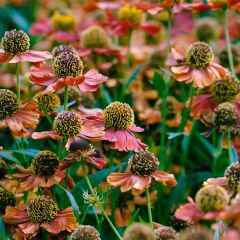
Helenium Rubinzwerg
- Flowering time August to November
- Height at maturity 80 cm

Helenium Mardi Gras
- Flowering time August to October
- Height at maturity 60 cm
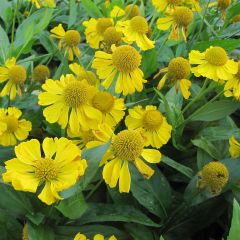
Helenium Tijuana Brass
- Flowering time August to October
- Height at maturity 1,50 m
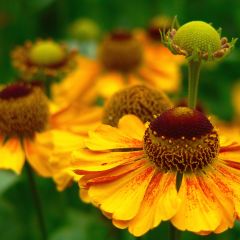
Helenium Zimbelstern
- Flowering time September to November
- Height at maturity 1,20 m
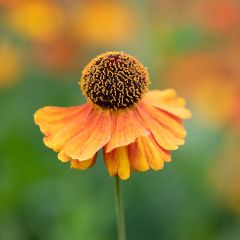
Helenium Waltraut
- Flowering time August to October
- Height at maturity 80 cm

Helenium Pumilum Magnificum
- Flowering time July to September
- Height at maturity 80 cm
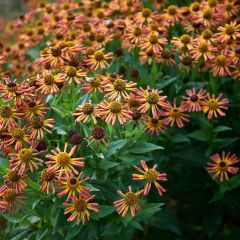
Helenium Loysder Wieck
- Flowering time August to October
- Height at maturity 90 cm
Discover other Helenium
Planting
Where to Plant Helenium
Very easy to grow, with excellent hardiness (beyond -15°C), Helenium thrives almost anywhere in France and adapts well even in coastal areas.
Once well-established in a spot it likes, it flourishes year after year, becoming increasingly floriferous, sometimes even invasive to the point of overwhelming neighbouring plants. It may self-seed spontaneously. It struggles with close proximity to other plants, so choosing the right planting location is essential: give it space!
Select a sunny, sheltered spot to prevent taller varieties from being bent by the wind.
This beautiful perennial grows in heavy, clayey, and marshy soils and is sometimes used to naturally drain waterlogged areas. While it tolerates most soil types as long as they’re not too dry, it truly thrives in deep, fertile soil. The soil should be rich in organic matter to ensure abundant flowering. In poor soil, it will survive but never achieve lush growth.
It prefers well-drained soil that stays moist in summer, especially in its early years, though it will tolerate occasional drought as it matures. Winter waterlogging is fatal—it needs free-draining soil.
Versatile, it suits all garden styles and works well in borders or flower beds. Taller varieties like ‘Kugelsonne’ form imposing flowering clumps at the back of borders, while compact varieties add movement to edges. Some reasonably sized cultivars also thrive in pots.
When to Plant Helenium
Helenium is best planted in spring (March–April) in colder regions or in autumn (September–October) elsewhere, avoiding frost and drought periods.
How to Plant Helenium
In the ground
Space plants 30–40 cm apart and plant in groups: 3–5 pots per m² is sufficient for a striking display, given this perennial’s vigorous growth.
Helenium is a hungry plant—enrich the soil with well-rotted compost.
- Prepare the soil thoroughly, removing weeds and stones
- Plant in a mix of compost and potting soil
- Mulch in spring with pine bark to retain moisture—key for prolonged flowering
- Water regularly after planting
- In spring, protect young shoots from slugs and snails
Potted Helenium needs even more water than in-ground plants. Choose compact varieties.
- Plant in a large container with moist compost-rich potting mix
- Ensure good drainage with gravel or clay pebbles at the base
- Mulch and water frequently—never let the compost dry out
- Feed regularly with organic fertiliser during flowering
Helenium Care
Helenium is a low-maintenance perennial plant as long as it doesn’t lack light or water in summer. Once well established, it requires little care provided the soil is well-draining and sufficiently fertile and moist in summer.
During the first springs and summers, give it generous watering. In periods of drought, water daily but without flooding it.
Helenium care is straightforward:
- In spring, before new growth appears for late-flowering varieties or in autumn after flowering, cut back dry stems to 15 cm above ground using pruning shears.
- Take this opportunity to add one or two spadefuls of compost at its base: remember, they thrive in fertile soils,
- Mulch in May to ensure sufficient moisture at the base during summer.
- Stake taller varieties if necessary.
- In summer, remove flowers as they fade to prolong blooming.
Every 3 to 4 years, in spring or autumn, divide the largest clumps if the plant shows signs of fatigue to rejuvenate it.
Diseases and potential pests
Hardly ever troubled by disease, Helenium has only a few enemies: gastropods, at the start of the growing season. In spring, protect its young shoots from the appetite of slugs and snails. Discover all our advice in our guide: “Slugs: 7 effective ways to control them naturally”.
It may occasionally be affected by powdery mildew and leaf spot (rust), especially when planted in too much shade, in a somewhat confined position, or in soil that is too heavy and damp. To prevent and treat powdery mildew, follow our advice: “Powdery mildew or white mould: prevention and treatment”.
Propagation
To propagate Helenium, division remains the least tedious method. Root cuttings are possible but rather delicate. Sowing is a method that yields a large number of plants, though we only recommend it for botanical species where the flower colour remains true.
Division
Dividing clumps should be done after 3 or 4 years, once the plant is well established. Divide late-flowering heleniums (which bloom in autumn) in March, and early-flowering heleniums (which bloom in summer) in October.
- Using a sharp spade, cut out sections from the outer edges of the clump, ensuring each has at least one bud and root
- Take the opportunity to rejuvenate the plant by keeping only the outer sections and discarding the central clump
- Replant these divisions immediately in well-loosened, moist garden soil
How to Sow Helenium
Helenium is a perennial that is very easy to grow from seed. Sow directly in the ground in autumn or May, or in seed trays from January to March using well-ripened seeds collected in autumn or purchased seed packets.
- Sow in a mix of compost and river sand, barely covering the seeds
- Place the tray in a warm frame at 15-20°C
- Water regularly but avoid waterlogging the substrate
- Germination takes 2 to 3 weeks
- When seedlings have two true leaves, transplant into individual pots
- Plant them out in autumn or the following spring once the seedlings are well-established
- Plants will flower from the second year after sowing
→ Learn more about propagating heleniums in our tutorial guide!
Pairing Helenium in the Garden
Helenium is particularly inspiring for creating a naturalistic-style garden, or a mixed border in the spirit of cottage gardens with other easy-going, upright perennials. Its original, sun-like flowers splash summer and autumn borders and flower beds with fiery brightness.
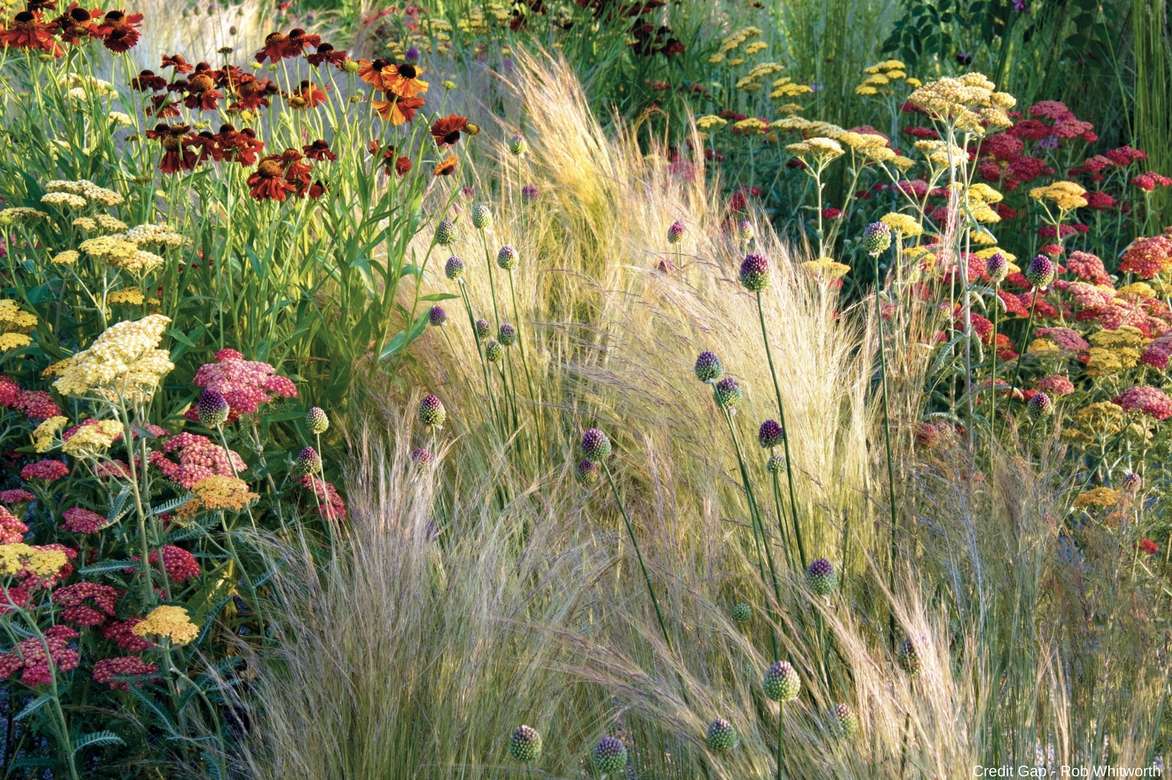
A stunning natural scene: Achillea ‘Terracotta’, Achillea ‘The Beacon’, Achillea ‘Paprika’, Helenium ‘Moerheim Beauty’, Stipa tenuifolia, Allium sphaerocephalon.
It is essential for composing wild-looking scenes, lush and colourful in the heart of summer.
Planted in groups rather than singly, it gives substance to a border with its strong chromatic presence, either by adding contrast or in a graduated or monochrome version.
Its intense colours can easily be paired with the complementary colours (crimson/blue) of asters and salvias for a joyful, rebellious effect.
For an explosive mix of tones, pair it with Echinaceas, Oriental Poppies, Rudbeckias, Daisies, Yarrows, Agastaches, Helianthus, Coreopsis, Globe Thistles, perennial chrysanthemums or Phlox.
Its slightly unruly habit will provide, in an exuberant summer border, a contrast in form with plants with more defined outlines such as dahlias, red hot pokers, cannas, and crocosmias. Airy perennials like Gaura, Baby’s Breath, and ornamental grasses such as Miscanthus will add softness and movement as a counterpoint to Helenium’s somewhat stiff habit.
At the edge of a border, compact Heleniums will work wonders alongside Salvias, Daylilies, and Heucheras, which will beautifully enhance its warm hues.
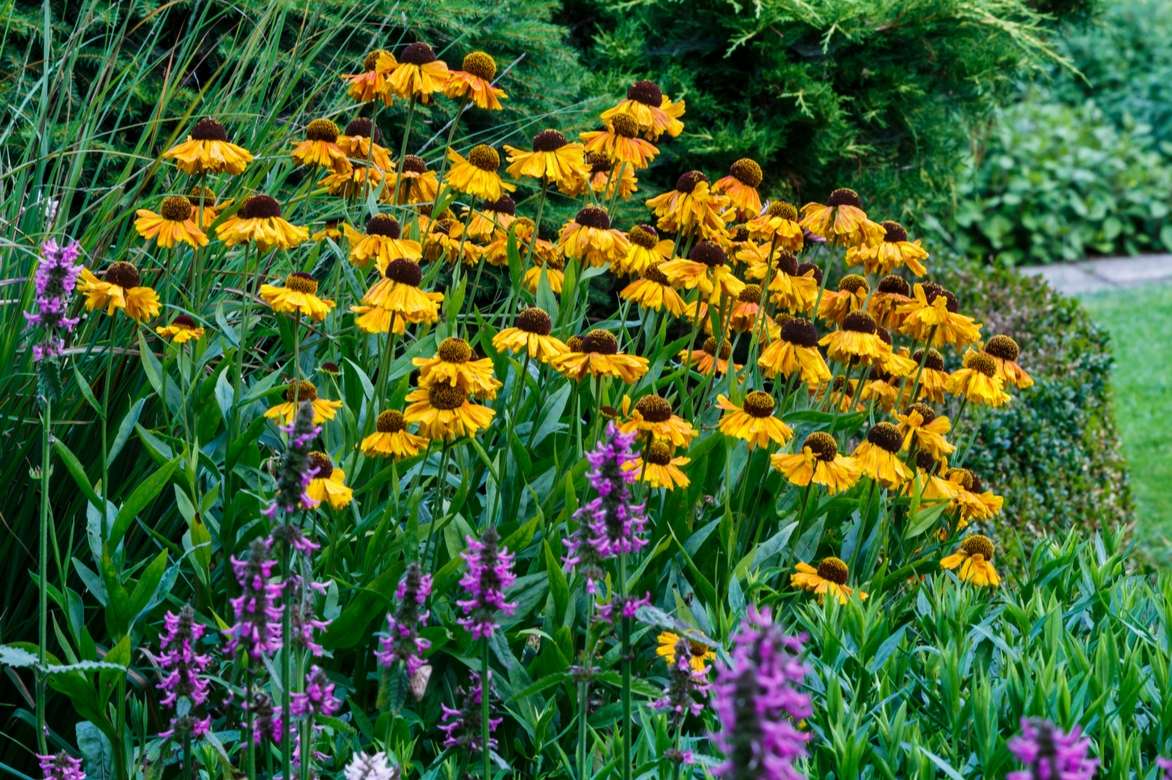
A planting idea: Helenium ‘Windley’, Miscanthus sinensis ‘Gracillimus’ and Stachys officinalis.
The grey or blue-tinged foliage of Artemisias or Santolinas, hostas, and ornamental grasses (Blue Fescues) will be perfect to temper the fire.
It can also be paired with a spindle tree or Japanese maple with sumptuous autumn foliage.
→ Discover more Helenium planting ideas in our advice sheet.
Useful resources
- Discover the most beautiful heleniums, including some rare and exclusive varieties in our Helenium collection
- Virginie’s expert advice: Heleniums, the most beautiful varieties, 6 ideas for pairing Heleniums
- Subscribe!
- Contents
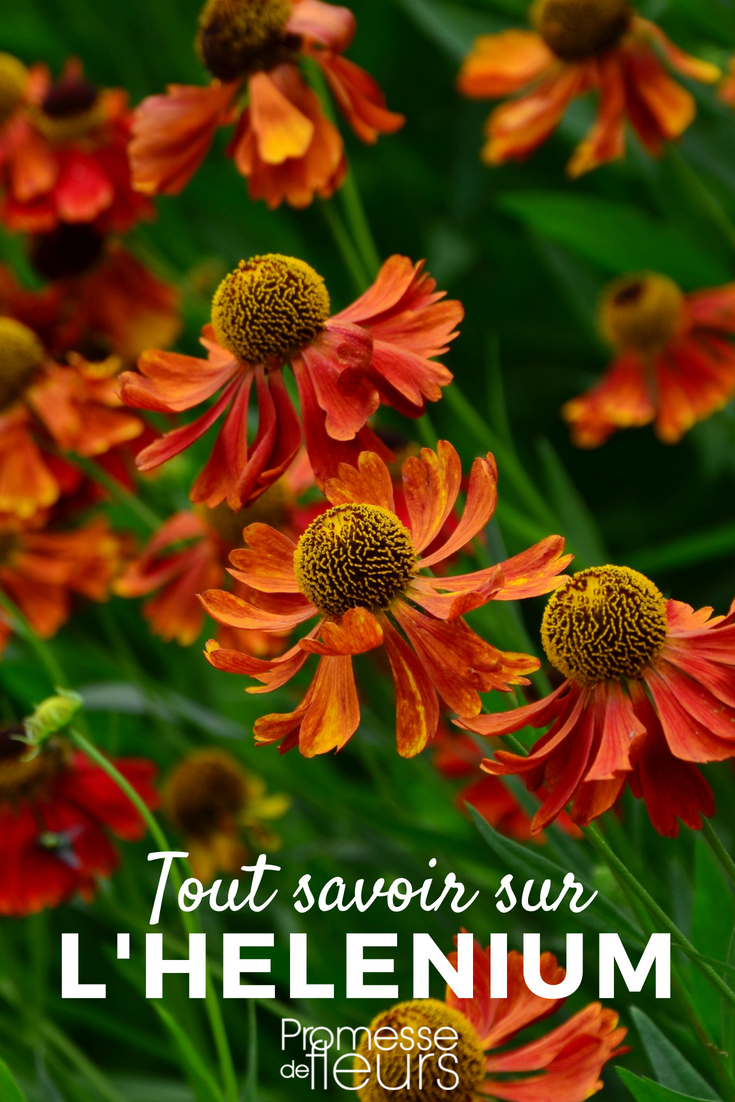


































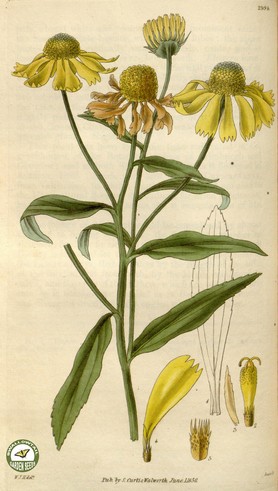
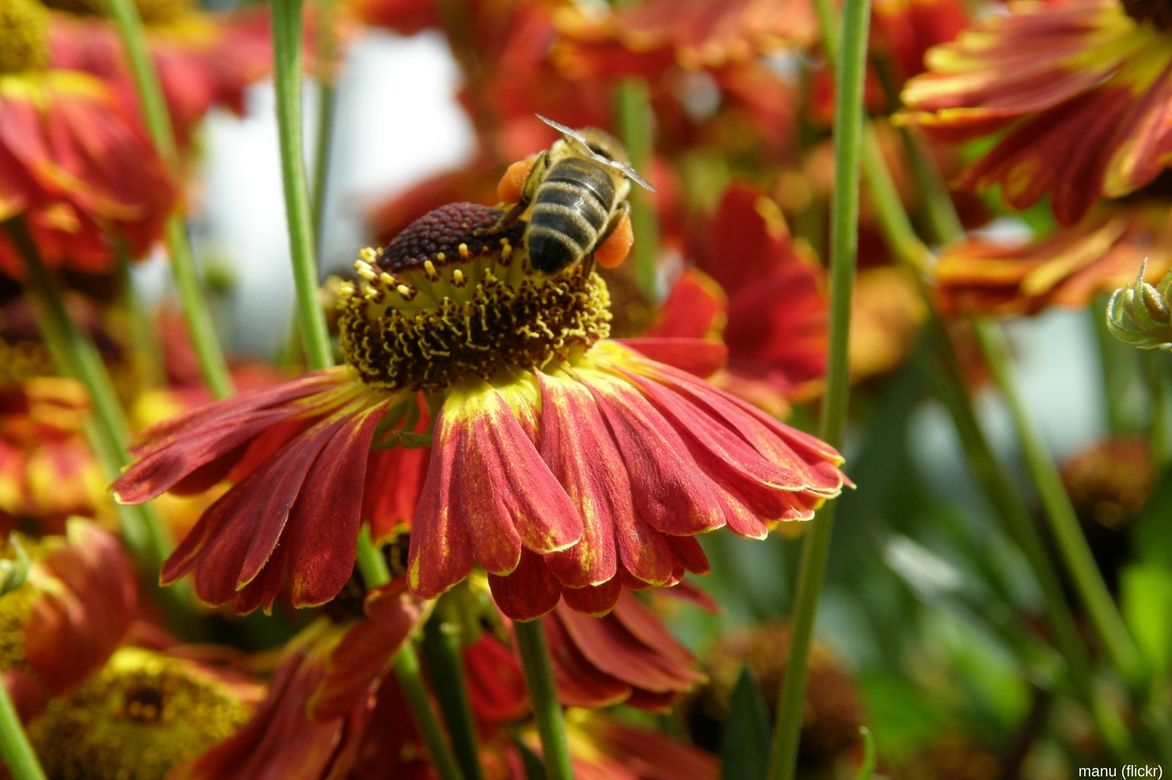
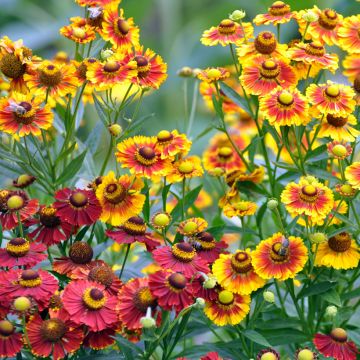
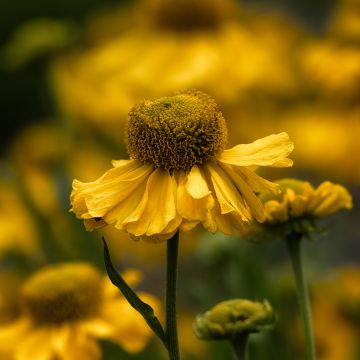
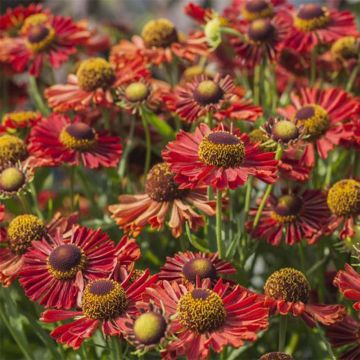

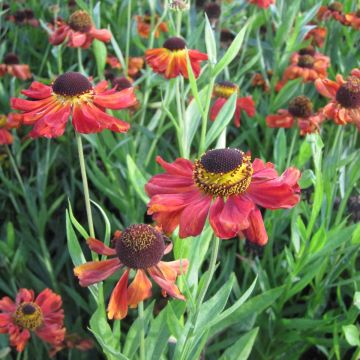
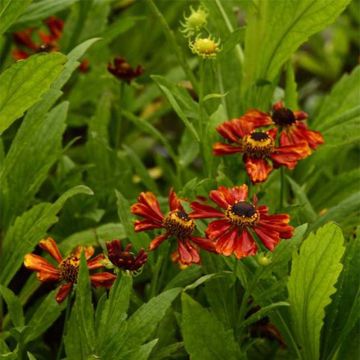
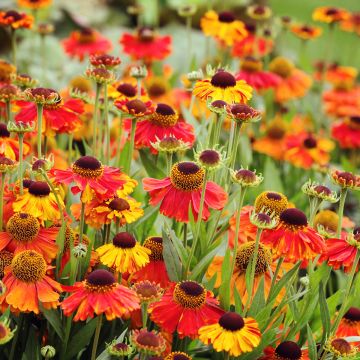
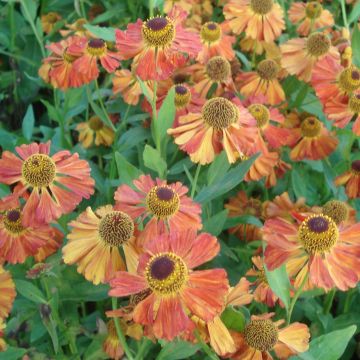

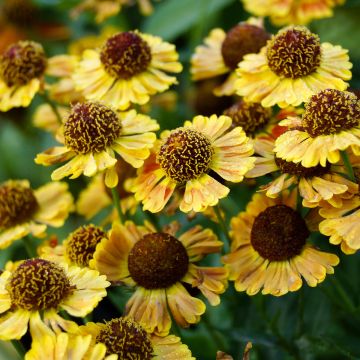
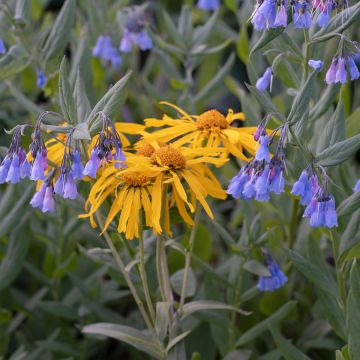
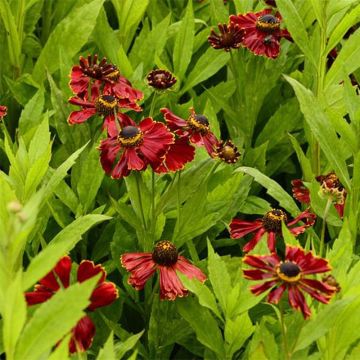


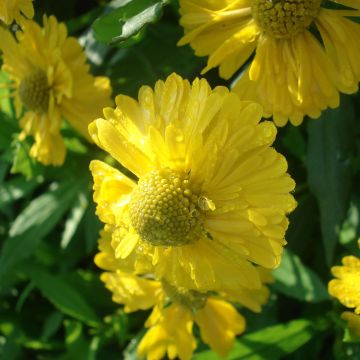
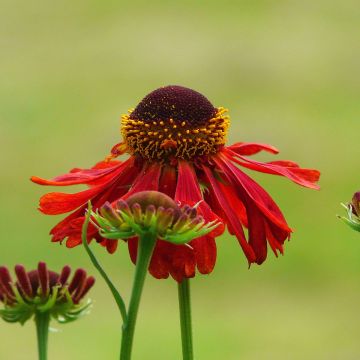
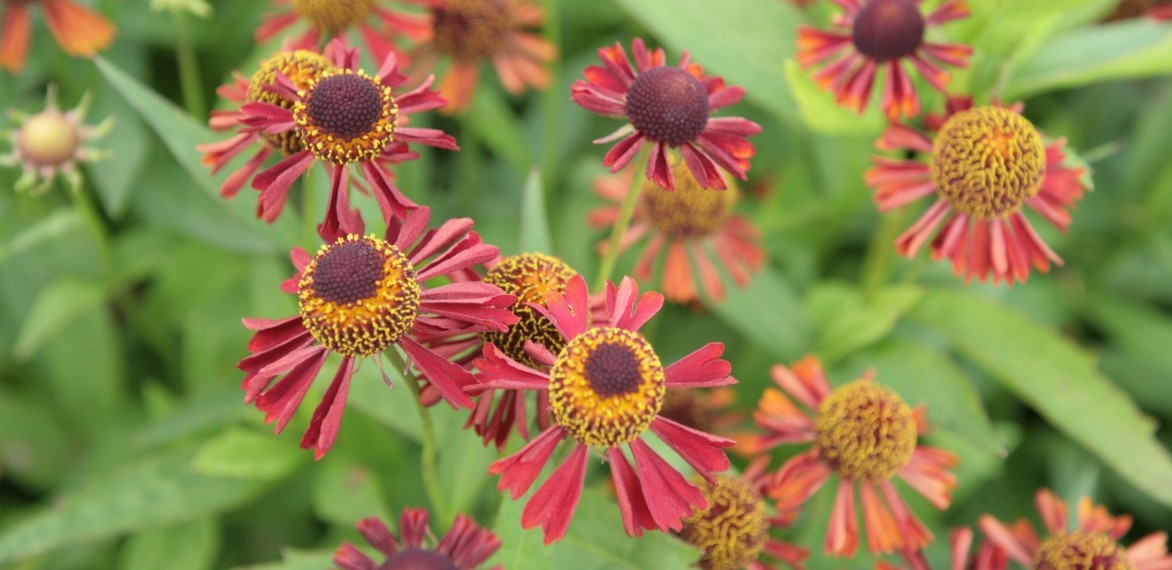
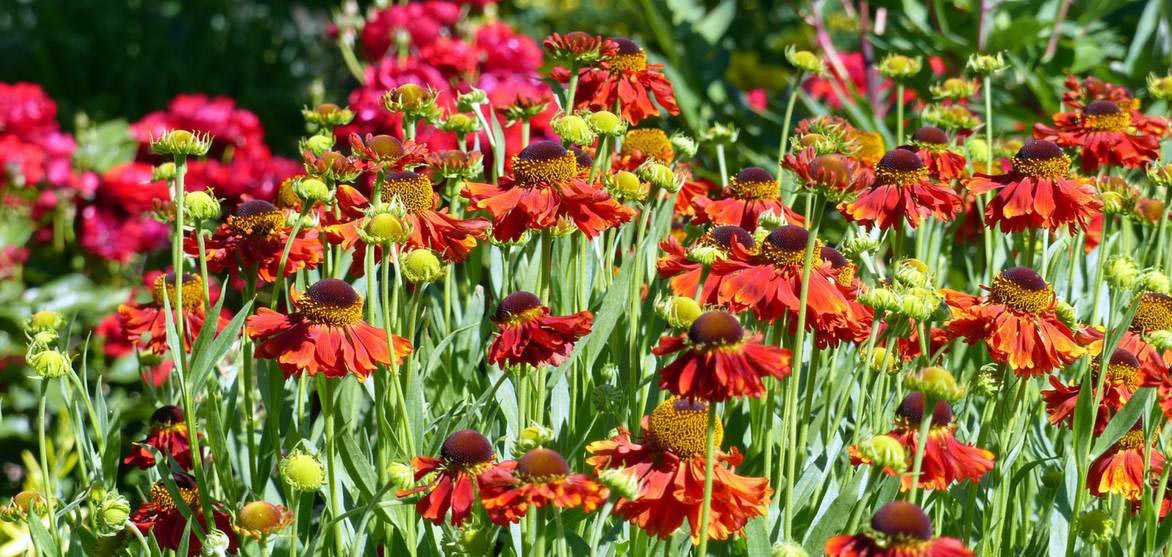

Comments